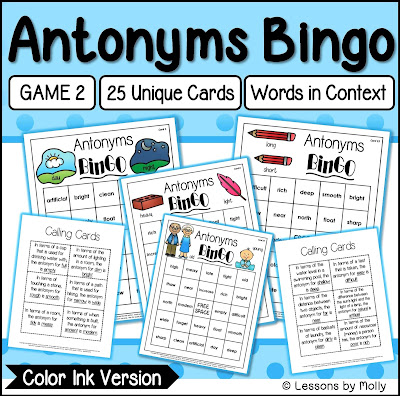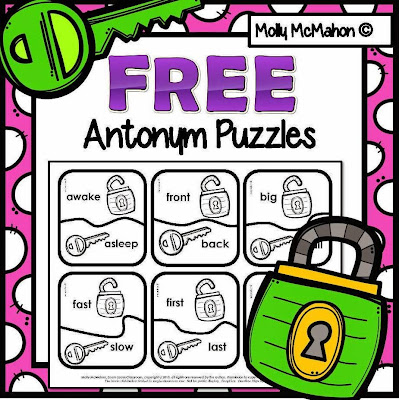I have a free antonyms puzzles file! You can get it by scrolling down to the end of this post. If you'd like to read some of my thoughts about antonyms, read on.
My Own Experience My own first memory of when I understood the concept of antonyms was through the use of a seesaw. I observed myself go up and down as my friend was in the opposite position. I was five or six years old. This kinesthetic experience caused another light bulb to be turned on in my brain. I now knew what an antonym was.
Teaching Antonyms in the Early Years When our students are kindergartners, we offer them visual, tactile, and kinesthetic examples of opposites. We flick the classroom lights ON and OFF. We have the children speak LOUDLY. Then we have them talk SOFTLY. We have them rub their fingers against a SMOOTH stone. Then we have them feel a ROUGH stone.
Teaching Antonyms in Lower to Middle Elementary When our students are second, third, and fourth graders, they begin to READ antonyms. As educators, we have them find and match antonym pairs together. We have them share their own ideas of antonyms. Antonyms are an important part of vocabulary development. They are woven in the Common Core Standards as well as in the Virginia Standards of Learning. (If you are curious about where these standards are found, view the listings at the end of this post.)
The English Language The English language as many words that have multiple meanings. That becomes a deficiency when kids match antonyms with words that have more than one meaning. The word, "north" is usually thought of as the antonym for the word "south". However, many words have multiple meanings. Therefore, antonyms should be taught in context.
Let's take a look at the word "low".
Here are a few examples of what the word, "low" can mean:
1. a position in space
2. the pitch of a voice
3. an emotion when feeling "down"
4. a score on a test
"Bobby's" Experience.
Bobby is a young lad in third grade. His third grade teacher is playing a game with antonyms. It's Bobby's turn and she has asked him to tell her what the antonym for "low" is. Bobby thinks for a moment, and answers with the word "happy". The teacher is puzzled. She expected Bobby to say the word "high". Bobby did not know what his teacher was thinking. Bobby's teacher did not provide a background for which she was using the word "low".
It's no wonder that children get confused when required to complete work with antonyms. If we do not offer a structure behind the vocabulary that we are teaching, it becomes an act of memorizing antonym pairs instead of what the original purpose of the skill was. That is, to increase a child's knowledge of word meanings.
What Students Need to Know There are two prerequisites that a child must have in order to be successful with antonyms. The first one is the concept itself. (I got the concept after the seesaw ride.) The second thing needed is language development. If a child doesn't know the meaning of a word, it will be impossible for him/her to pair it with an antonym. When a child is required to complete a worksheet on antonyms, there is a third prerequisite. That is reading proficiency. A child could have the concept AND the vocabulary but lack the reading ability.
My Products If you have visited my store, you know that I enjoy making bingo games. Six of my most recent products include antonym bingo games. I made a beginners level. Then I made a game that is one step above beginners. I gauged the levels by the difficulty of the words. I made antonym bingo games that are printed with BLACK ink. I also made antonym bingo games that require COLOR ink. There are also bundle deals. Each bingo game has two sets of calling cards. The first set includes the antonyms for the words printed on the bingo sheets. The second set of antonyms provides a context for how the words can be used.
Here are a few pictures from the beginners set:
This is from the color set for the beginners version.
Everything seen here is also available in printer friendly, BLACK ink.
I used images from Whimsy Clips on the bingo sheets. I use the same 24 words on each sheet.

The images on the bingo sheets provide children with a visual example of an antonym.
In all, there are 25 bingo sheets with 5 templates (images) included - five bingo sheets per template.
There are 25 bingo sheets in the second game. There are 4 templates (images) used.
There are 24 words used in the second bingo game. The same 24 words are used on every bingo sheet.
The reading level as well as the vocabulary words used is a higher level in set 2 compared to set 1.
If you are interested in any of these games, click an image below:
Here are the k-5 Common Core standards which are tied to antonyms:
These are the related Virginia Standards of Learning which were adopted in the year 2010:
SECOND GRADE - Oral Language - 2.2-d
THIRD GRADE - Reading - 3.4-b
FOURTH GRADE - Reading - 4.4-b
FIFTH GRADE - Reading - 5.4-c
If you have read this blog post this far, then you deserve a FREE antonym center for your class. Click on the image below to get it!
Thank you for reading and following me.














No comments:
Post a Comment